Have you ever hesitated to switch threads in the middle of stitching a line, because you weren’t quite sure how to invisibly end the thread and start a new thread without causing a break in the line?
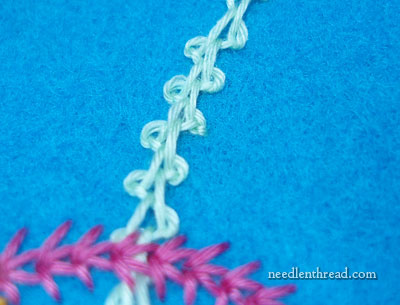
On more complex stitches (like the Spanish Knotted Feather Stitch in the photo above), the question of ending a thread mid-line and starting a new thread can be a bit tricky.
A couple weeks ago, when I introduced the Stitch Glitch series here on Needle ‘n Thread, one reader asked for a demonstration on how to end an old thread and begin a new thread with Spanish Knotted Feather Stitch in the middle of a line.
So today, I’m going to show you how to do that, and also talk a little bit about figuring out how to end old threads and begin new threads with other stitches, without causing a visible break in the line, so that you can apply the concepts to other stitches.
If you’re not familiar with the stitch, you might want to take a look at the how-to video for the Spanish Knotted Feather Stitch. It’s a Really Pretty Stitch, and excellent for decorative lines and curves, borders, and so forth. It’s worth adding to your stitch arsenal!
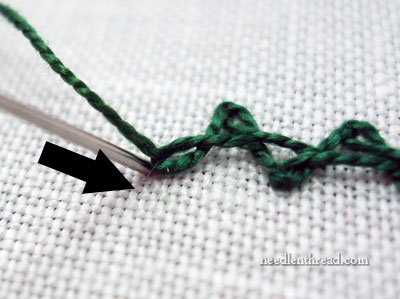
The Spanish Knotted Feather Stitch is made up of a series of kind of criss-crossed, alternating twisted chain stitches. So, when ending the whole line, or ending in the middle of the line, of the Spanish Knotted Feather Stitch, you have to end the thread with an anchor stitch over one of the twisted chain stitches, just as you would chain stitch of any sort. Just take the needle down on the outside of your last chain stitch, and stitch right over the loop.
But that part’s pretty easy, because that’s how you end the line, anyway, right?
The question is, what do you do next to continue with a new thread, without a noticeable break in the line. First, you have to look at the anatomy of the Spanish Knotted Feather Stitch (or of any stitch you happen to be working with). Ask yourself, “Where does the thread move next?”
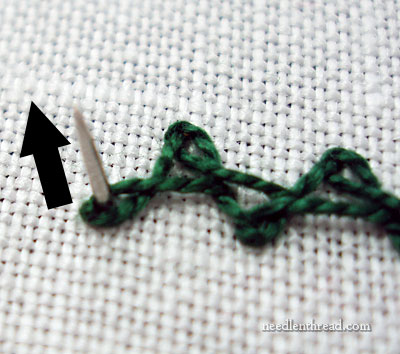
With Spanish Knotted Feather Stitch, the thread moves from the middle of the twisted chain stitch loop back to the center of the line, to start a new twisted chain stitch. This means our thread needs to emerge from the middle of that last chain stitch loop, just as it would do, had we not ended the thread.
To get to that starting point, then, we’ll bring the needle (with the new thread attached) up into the middle of the last chain stitch loop that we just anchored.
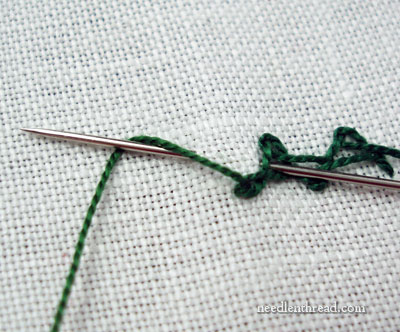
Once you pull through, you’ll see that you’re in position to begin the next part of the stitch, by heading back to the center of the line, taking the needle down into the “elbow” formed by the twisted chain, and creating a new twisted chain stitch on the other half of the line. From here on out, you’re set to continue the line with a nice, new, long thread!
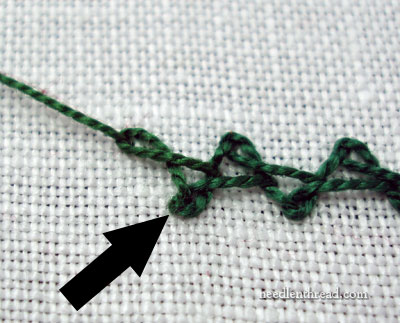
The arrow points to the anchored loop. It’s not really noticeable – you’d have to really search for it to find it, once the line is complete.
To recap, when ending an old thread and starting a new thread, first, end the old thread in the normal way that you would end the line of stitches. Next, think “Where would my thread move next?” and figure out where the new thread has to be, to make that next movement in the stitch. Bring your thread up there, and continue with your line.
You’ll find some other articles dealing with similar subjects here on Needle ‘n Thread, and I’ve recently tagged some of them with the Stitch Glitch tag. They include questions like stitching a chain stitch circle with an invisible join, stitching sharp corners with stem stitch, starting a new thread in a chain stitch line, and so forth.
Hope you find them helpful!
If you have any stitch difficulty you’d like to see worked out in a photo tutorial, feel free to leave a comment below and I’ll try to help you out!







REQUEST FOR STITCH GLITCH: Please show how to start AND end/start new threads when doing buttonhole stitch, as in Hardangar, so it doesn’t show. Thanks, Janet.
Hi Mary, I wait every day for your email and watching with awe at your blue & gold project. I understand your feelings and it makes me feel better to know that you have little “precious” moments to. I spend so much time unpicking my Staight lines that I worry about wasting my silk threads.
Could you have started the stem stitch in a couple of lines of the medium blue and then did one dark then another medium and then a dark so that it looked more graduated. I am only asking this question because I have no idea myself but would that have solved your problem or not?
Thank you so much Mary!
Celine
I am really having trouble with the spiral trellis stitch. I have looked at tutorials (yours and videos). I have practiced with #12 perle coton with some success. Then I get to the sampler, which uses a silk thread and I get what can only kindly be described as a messy bird’s nest. Too loose? Too tight? Is the base the problem? I am stumped.
Thanks for any help you can send my way.
Luara
You can tell how messed up I am–I misspelled my own name in the previous post. Sigh.
Laura
I started the quest to learn some new stitch styles and I have been absolutely thrilled to learn so many and implement them into my projects. Thank you so much.